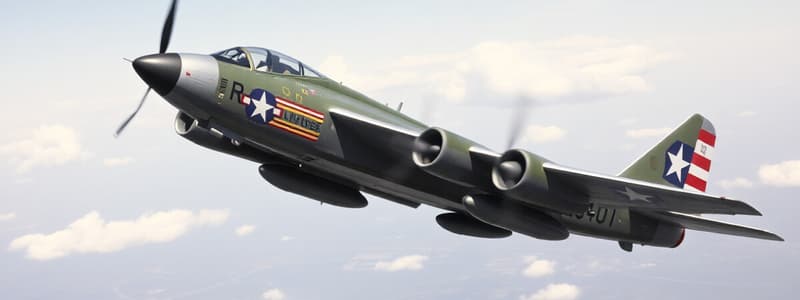Podcast
Questions and Answers
What was a key aspect of LeMay's bombing strategy during WWII?
What was a key aspect of LeMay's bombing strategy during WWII?
- It aimed to minimize destruction to civilian infrastructure.
- It primarily focused on ground troop support.
- It utilized exclusively naval air power.
- It heavily relied on strategic bombardment over urban areas. (correct)
Which of the following statements accurately reflects LeMay's perspective on the use of atomic bombs?
Which of the following statements accurately reflects LeMay's perspective on the use of atomic bombs?
- He considered them unnecessary as the main objectives had already been achieved. (correct)
- He believed they were essential for Japan's swift capitulation.
- He thought they provided a means to prevent further loss of life.
- He was indifferent about their impact on military strategy.
How did LeMay's leadership style differ from that of Joseph Stilwell?
How did LeMay's leadership style differ from that of Joseph Stilwell?
- Stilwell preferred unconventional tactics in warfare.
- LeMay exhibited more aggressive and assertive behaviors. (correct)
- LeMay was more focused on traditional military strategies.
- Stilwell emphasized flexibility and rapid adaptation in operations.
What was the impact of operational weather conditions on bombing missions in WWII?
What was the impact of operational weather conditions on bombing missions in WWII?
What was one consequence of the bombing campaigns conducted from the Marianas?
What was one consequence of the bombing campaigns conducted from the Marianas?
What was a key element of LeMay's bombing strategy in World War II?
What was a key element of LeMay's bombing strategy in World War II?
How did Henry Stimson's views contrast with the realities of wartime bombing?
How did Henry Stimson's views contrast with the realities of wartime bombing?
What did Stilwell fail to comprehend about modern warfare?
What did Stilwell fail to comprehend about modern warfare?
In what way did LeMay's strategy differ from Hansell's strategy in the Pacific theater?
In what way did LeMay's strategy differ from Hansell's strategy in the Pacific theater?
Which aspect of leadership styles is highlighted through the actions of LeMay and Stimson?
Which aspect of leadership styles is highlighted through the actions of LeMay and Stimson?
Flashcards
Stilwell's Perspective on Warfare
Stilwell's Perspective on Warfare
Stilwell, a general, believed that traditional warfare involved direct conflict between armies.
LeMay's Bombing Strategy
LeMay's Bombing Strategy
LeMay's air raids targeted entire cities, leading to immense destruction and civilian casualties.
Stimson's Obliviousness
Stimson's Obliviousness
Stimson, the Secretary of War, was seemingly unaware of the destructive nature of the air raids.
Atomic Bomb Decision-Making
Atomic Bomb Decision-Making
Signup and view all the flashcards
Impact of Airpower on Warfare
Impact of Airpower on Warfare
Signup and view all the flashcards
Enola Gay mission
Enola Gay mission
Signup and view all the flashcards
LeMay's firebombing campaign
LeMay's firebombing campaign
Signup and view all the flashcards
LeMay's opinion on atomic bombs
LeMay's opinion on atomic bombs
Signup and view all the flashcards
Vinegar Joe
Vinegar Joe
Signup and view all the flashcards
Strategic Bombing
Strategic Bombing
Signup and view all the flashcards
Study Notes
Military Historian's Perspective on Curtis LeMay
- Military historian Conrad Crane, an expert on Major General Curtis LeMay, discussed LeMay's mindset when he took over Twenty-First Bomber Command in January 1945.
- LeMay, unlike his predecessor Haywood Hansell, was adaptable and open-minded, not fixed in his strategic approach.
- LeMay was critical of the Navy's infrastructure in the Marianas, emphasizing the primitive facilities.
- LeMay, initially, attempted to follow Hansell's strategy but faced obstacles.
- Problems with military infrastructure, weather conditions (jet stream, clouds), and visual bombing capabilities led to LeMay's strategic shift.
Night Raids and Napalm
- LeMay recognized the constraints of daylight precision bombing due to weather and enemy defenses and transitioned to night raids.
- He prioritized carrying as much napalm as possible to compensate for reduced targeting capabilities.
- This strategy involved minimizing defensive systems by removing unnecessary ammunition and gunners.
- The firebombing of Tokyo, on March 9, 1945, was the result of LeMay's adaptation of methods for bombing and is a significant event of the Pacific Theater during WWII.
Bombing of Tokyo
- LeMay's initial bombing mission(s) against the Nakajima aircraft plant in Tokyo was unsuccessful.
- LeMay faced similar challenges as Hansell in achieving a Japanese surrender through air attacks.
- LeMay realized his need for alternative strategies to force Japan's submission, including targeting Tokyo to compel surrender from the air.
LeMay's Strategic Decisions
- LeMay's strategy involved taking out the Nakajima aircraft plant in Tokyo.
- LeMay aimed to improve his ability to execute precise bombing runs by overcoming the limitations of the jet stream and cloud cover.
- He chose to attack at lower altitudes and during the night to evade enemy defenses, changing from daylight to nighttime precision bombing.
LeMay's Leadership Style
- LeMay's leadership style was characterized by decisive action and unwavering dedication to achieving military objectives.
- LeMay showed flexibility and adaptability in adjusting his strategy despite initial setbacks.
- LeMay's strategic ideas proved effective in forcing Japanese surrender.
- LeMay aimed to minimize war time and casualties by making the war as short as possible.
Studying That Suits You
Use AI to generate personalized quizzes and flashcards to suit your learning preferences.




